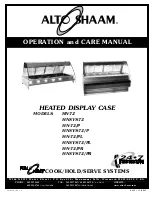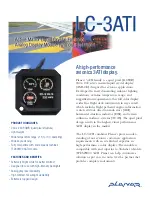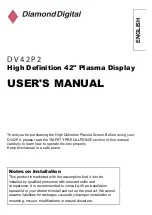
G SERIES PILOT’S GUIDE .
INSIGHT
INSTRUMENT CORPORATION BOX 122, FORT ERIE, ONTARIO, L2A 5M6
32
After the sensor is connected and the software updated, you will find a new screen has been added, which contains the
vibration spectrum. The vibration analysis only takes place when the engine is running and a valid rpm signal is detected.
In regards to the vibration graph, the vertical axis represents the amount of vibration energy and the horizontal axis repre-
sents the frequency spectrum expressed as multiples of crankshaft rpm. When it is operating, the screen will come alive
with a waveform that represents the engine motion, presented in a spectral format with the crankshaft energies appearing
at the 1x mark on the bottom scale. Propeller vibration will likewise be synchronous with the crankshaft vibration.
Other sources of vibration will tend to produce energies at other frequencies.
For example, camshaft vibration tends to accumulate at .5x, since the cam turns at 1/2 the rate of the crankshaft. Magneto
vibration will appear at 1.5x in a 6-cylinder engine. Alternator vibration may appear somewhere around 3x or 4x, depend-
ing on the ratio it is driven at.
A gear-driven alternator may appear in a different axis than the crankshaft does, if it is mounted at 90deg to the engine,
although ANY source of vibration will show some energy in all three axis. Complex vibration as generated by reciprocating
machinery will also produce a great number of harmonic spikes, which at first glance may seem confusing. Experiment
with running the engine at different power settings under different conditions to get a feel for what is a “normal” spectrum
for your particular engine.
You may examine the various sub-screens by pushing the top button. There are 6 screens to examine, each of the prima-
ry axis (x, y and z) and an averaged version of each. The averaged version will be much “cleaner” and contain less noise
than the raw measurement and is the preferred screen to examine for each axis. The bottom knob can also be pushed to
enter a zoom mode. When in zoom mode, turning the bottom knob will allow you to scroll through the waveform. The cur-
sor will also “snap” to nearby vibration spikes to make it easy to examine them. Continue to press the bottom knob to set
progressively higher zoom modes. A further press when at maximum zoom will return you to the overall view.
Pressing and holding the top button will trigger the G3 to save the present vibration waveform for future reference.
The waveform will be stored as a series of hexadecimal bytes in the log file.
It is expected that the vibration functions will be used as a “condition-monitoring tool”. Since every engine is different,
everyone’s vibration spectrum will look unique and it would be impossible to generalize the interpretation of the spectrum.
The user will come to recognize what a “normal” spectrum looks like for their engine and by periodically scanning the
vibration screen can recognize when potential trouble is developing.
When a new spike appears or an existing spike begins to show signs of higher than normal amplitude further investigation
is warranted.
If you take a step back from the EGT/CHT idea to explore engine monitoring in general, you discover that at least half the
engine monitoring solution is missing. EGT analysis reveals combustion phenomenon but simply ignores mechanical prob-
lems.
By the time a mechanical problem shows up in EGT, if it ever does, the damage is done and it is far too late to do anything
about it.
Vibration analysis is the key to pre-emptive detection of mechanical problems.





































